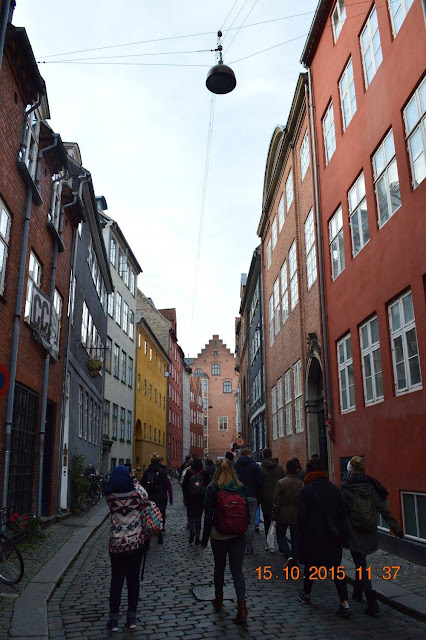Date of visit: 15th October 2015
First and foremost before I proceed with historical background of the City Court of Copenhagen, I wish yo thank a "Free Tour" team who has brought me to this court in the first place. It was my wish list to visit all the court houses in the cities that I've visited, for the same purpose when people craving for Hard Rock Cafe t-shirts were hunting the shop to complete their collection. Reason being, the court house has been a place where people since ancient time seek justice and usually it is located inside the most historical place and building. The same with my city, Sultan Abdul Samad Building was where the highest court of the country use to reside before the Government built a new one in Putrajaya. The building is one of the most stunning and beautiful in Kuala Lumpur city.
If not because of the free tour guide, who took us along the unknown, yet beautiful lanes leading the high court, I would not be able to find them myself. In addition to that, our tour guide has given his best by explaining the narrative of the court choronolgy vis-a-vis how the Copenhagen city was built to what it is now. It is here the former city house was located before it shifted to the present location (refer to earlier entry).
Our knowledgeable guide explaining the rules and some background of the 2.5 hours walking trip around Copenhagen attraction at the City Hall Square in above and below photo.
This neo-classicist Courthouse,
designed by Professor C.F. Hansen, is a masterpiece of Danish architecture. In
1795, the former Town Hall, situated between “Gammeltorv” and “Nytorv”, was destroyed
in a fire which destroyed large parts of the city. The location of the former
construction is marked in the pavement at “Nytorv”. The present Courthouse was
erected in 1805-15, where the works being delayed due to the bombardment of
Copenhagen by the English in 1807, during the Napoleonic wars. Until 1905 the
building served both as courthouse and town hall. The building is now protected
and the front has been restored.
The Courthouse Annexe in
“Slutterigade” is a prison street where it was built in 1805-1816 for the prisoners. It
is attached to the main building by two large arches. It was rebuilt in 1904
and again in 1942 till 1944, when it was converted in order to house more courtrooms and
chambers. The architect of this court, Professor C.F.
Hansen, had also designed the Cathedral of Copenhagen (Church of Our Lady) as well
as a number of country houses in Schleswig-Holstein.
The inscription of the
Courthouse, on the front facing Nytorv “Med Lov skal man Land bygge” means “With
Law the Country shall be built”, is a quotation from the preamble to The Law of
Jutland, given by King Valdemar Sejr in 1241. Visitors may enter the hall
facing Nytorv between the impressive Ionic columns. In this hall, the 200 men
of the Citizens Guard were mustered. The room at the rear end of the Entrance
Hall served as a conference room for the City Council. To the right of the
Entrance Hall the main staircase is situated behind four Tuscan pillars. Near
the staircase, there is a room which was formerly the antechamber to the first
Criminal Courtroom.
This courtroom is almost 200 m²
and is still the largest courtroom. The room on the first floor with three
large windows facing Nytorv earlier served as courtroom for the “Landsover-
samt Hof- og Stadsretten” (Appeal Court and Court for Copenhagen prior to
1919). The room now serves as a conference room for the members of the court
and for ceremonial purposes. This main building has 17
courtrooms with chambers, and also houses the City Court’s administration.
With the inscription above the
former prison translates as “For General Security”, the Annexe houses 9
courtrooms with their chambers. One of the arches connecting the Annexe and the
main building is called “Bridge of Sighs” because prisoners were and still are
conducted via this bridge in order to attend their trial.
The City Court nowadays also uses
nearby buildings situated at Nos. 4 and 6 “Hestemollestræde” and No. 1
“Lavendelstræde”. In these buildings, the Probate Court, The Land Registration
Office, and the Enforcement Division are located. The City Court of Copenhagen is
the largest of Denmark’s 24 city courts. It has jurisdiction over a large part
of the Municipality of Copenhagen, Dragor, and Tarnby Municipalities
(approximately 400.000 inhabitants). The President of the Court is responsible
for the management of the Court. There are 42 judges, 15 assistant judges and
app.150 clerks, guards, and other staff members.
 |
| The Court courtyard |
The City Court is competent in handling
both civil and criminal cases. Like any other city courts, it comprises a
Probate Division, an Enforcement Division, and a Registration and Notarial Acts
Division. Like the other city courts of the Greater Copenhagen Area, The City
Court of Copenhagen, does not have a Bankruptcy Court. The Bankruptcy Court for
this area is a division of the Maritime and Commercial Court of Copenhagen.
 |
| Some of the colorful lane that we went through |








No comments:
Post a Comment